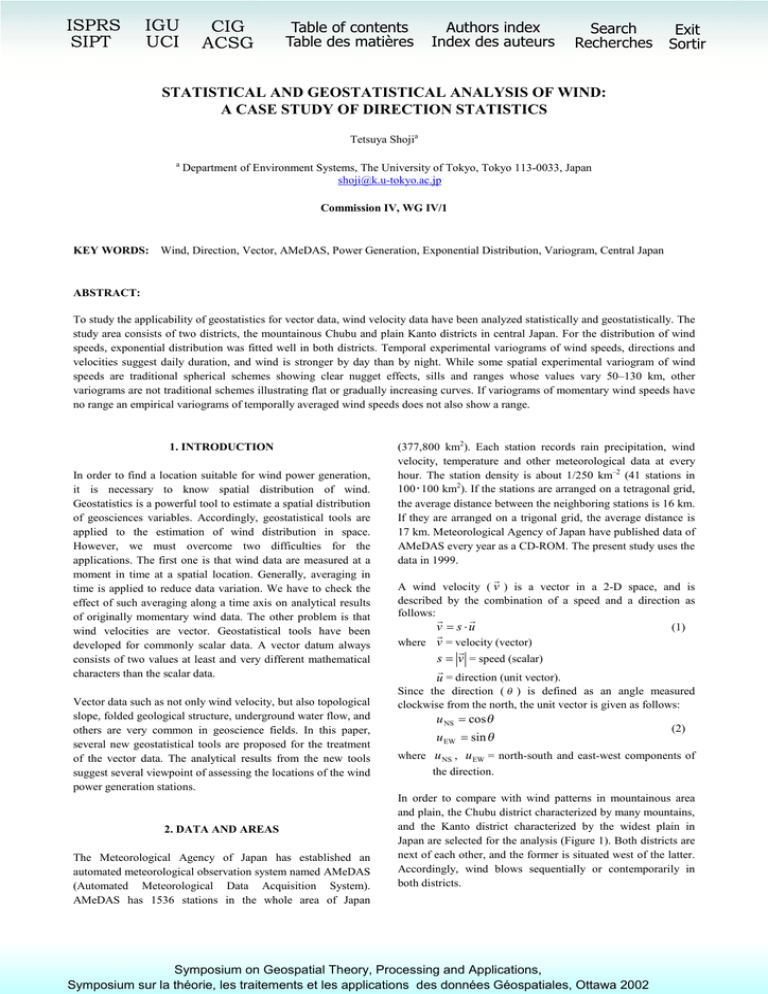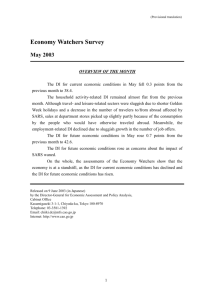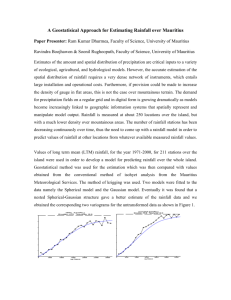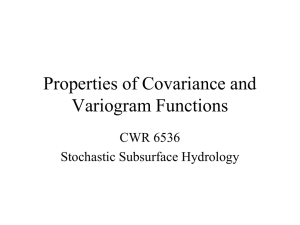STATISTICAL AND GEOSTATISTICAL ANALYSIS OF WIND:
advertisement

ISPRS
SIPT
IGU
UCI
CIG
ACSG
Table of contents
Table des matières
Authors index
Index des auteurs
Search
Recherches
Exit
Sortir
STATISTICAL AND GEOSTATISTICAL ANALYSIS OF WIND:
A CASE STUDY OF DIRECTION STATISTICS
Tetsuya Shojia
a
Department of Environment Systems, The University of Tokyo, Tokyo 113-0033, Japan
shoji@k.u-tokyo.ac.jp
Commission IV, WG IV/1
KEY WORDS:
Wind, Direction, Vector, AMeDAS, Power Generation, Exponential Distribution, Variogram, Central Japan
ABSTRACT:
To study the applicability of geostatistics for vector data, wind velocity data have been analyzed statistically and geostatistically. The
study area consists of two districts, the mountainous Chubu and plain Kanto districts in central Japan. For the distribution of wind
speeds, exponential distribution was fitted well in both districts. Temporal experimental variograms of wind speeds, directions and
velocities suggest daily duration, and wind is stronger by day than by night. While some spatial experimental variogram of wind
speeds are traditional spherical schemes showing clear nugget effects, sills and ranges whose values vary 50–130 km, other
variograms are not traditional schemes illustrating flat or gradually increasing curves. If variograms of momentary wind speeds have
no range an empirical variograms of temporally averaged wind speeds does not also show a range.
1. INTRODUCTION
In order to find a location suitable for wind power generation,
it is necessary to know spatial distribution of wind.
Geostatistics is a powerful tool to estimate a spatial distribution
of geosciences variables. Accordingly, geostatistical tools are
applied to the estimation of wind distribution in space.
However, we must overcome two difficulties for the
applications. The first one is that wind data are measured at a
moment in time at a spatial location. Generally, averaging in
time is applied to reduce data variation. We have to check the
effect of such averaging along a time axis on analytical results
of originally momentary wind data. The other problem is that
wind velocities are vector. Geostatistical tools have been
developed for commonly scalar data. A vector datum always
consists of two values at least and very different mathematical
characters than the scalar data.
Vector data such as not only wind velocity, but also topological
slope, folded geological structure, underground water flow, and
others are very common in geoscience fields. In this paper,
several new geostatistical tools are proposed for the treatment
of the vector data. The analytical results from the new tools
suggest several viewpoint of assessing the locations of the wind
power generation stations.
2. DATA AND AREAS
The Meteorological Agency of Japan has established an
automated meteorological observation system named AMeDAS
(Automated Meteorological Data Acquisition System).
AMeDAS has 1536 stations in the whole area of Japan
(377,800 km2). Each station records rain precipitation, wind
velocity, temperature and other meteorological data at every
hour. The station density is about 1/250 km–2 (41 stations in
100・100 km2). If the stations are arranged on a tetragonal grid,
the average distance between the neighboring stations is 16 km.
If they are arranged on a trigonal grid, the average distance is
17 km. Meteorological Agency of Japan have published data of
AMeDAS every year as a CD-ROM. The present study uses the
data in 1999.
r
A wind velocity ( v ) is a vector in a 2-D space, and is
described by the combination of a speed and a direction as
follows:
r
r
(1)
v = s ⋅u
r
where v = velocity (vector)
r
s = v = speed (scalar)
r
u = direction (unit vector).
Since the direction ( θ ) is defined as an angle measured
clockwise from the north, the unit vector is given as follows:
u NS = cosθ
u EW = sin θ
(2)
where u NS , u EW = north-south and east-west components of
the direction.
In order to compare with wind patterns in mountainous area
and plain, the Chubu district characterized by many mountains,
and the Kanto district characterized by the widest plain in
Japan are selected for the analysis (Figure 1). Both districts are
next of each other, and the former is situated west of the latter.
Accordingly, wind blows sequentially or contemporarily in
both districts.
Symposium on Geospatial Theory, Processing and Applications,
Symposium sur la théorie, les traitements et les applications des données Géospatiales, Ottawa 2002
Wind-GeoSpatial-Shoji-CD
02/03/18 (16:24)
Table 1. Correlation coefficients between wind speed and frequency cumulated from the high value side in some
statistical distribution models.
District Number of
Statistical Distribution Model
The Chubu district consists of many folding mountains and
volcanoes including Mt. Fuji, which is the highest in Japan. In
order to obtain the characteristics of wind in the mountainous
district, only the stations whose elevations are higher than 100
m above the sea level are selected in the district. 170 stations
are included in this district, and about 60 % of them recorded
wind data. The elevation of the highest worked station is 1350
m (the elevation of the highest station is 2730 m). The density
of stations is about 1/510 km–2. This means that the nearest
station distance is 23 km in a tetragonal grid, or 24 km in a
trigonal grid.
Chubu
Kanto
Lognormal
-0.9923
779097
-0.9696
-0.9909
1230815
-0.9657
-0.9929
Exponential
-0.9992
-0.9983
-0.9996
Total
“Total” means the total area of Chubu and Kanto.
50 0
The Kanto district consists of many fields and cities including
Tokyo, which has the largest population in Japan. The stations
lower than elevation 200 m are selected in this district. 81
stations are included in this district, but about 50 % of them
recorded wind data. The density of stations is about 1/490 km–2.
This means that the nearest station distance is 22 km or 24 km.
South-North/km
40 0
3. STATISTICS
30 0
20 0
10 0
3.1 Statistical Distribution of Speeds
First, basic statistics of speed, direction and velocity were
obtained from wind data in the Chubu and Kanto districts, and
the Chubu-Kanto total area defined by the combination of both
districts. We have empirically fitted three distribution
functions: normal, lognormal, and exponential distributions.
Table 1 summarizes sample correlation coefficients between
wind speeds and empirical cumulative frequency distribution
functions. All sample correlation coefficients are high.
Especially, exponential functions (Figure 2) show high
correlation coefficients: –0.999 for the Chubu district, –0.998
for the Kanto district, and –0.9996 for the Chubu-Kanto total
area. Figure 2 means that wind is stronger in the plain Kanto
district than the mountainous Chubu district. This feature has
been consistent, even if the data are treated in each month.
0
0
10 0
20 0
30 0
40 0
50 0
60 0
Wes t - E a s t /k m
Figure 1. A map showing the locations and the elevations of
the station points used in this study (open squares indicate
did not work for wind data). The areas bounded by red
lines and green lines represent the Chubu district and the
Kanto district, respectively. Elevations: brown ≥ 1000 m,
orange ≥ 500 m, yellow ≥200 m, yellowish green ≥ 100 m,
and green < 100 m.
1
0.1
Cumulative Normal Frequency
The fact that the correlation coefficient between wind speeds
and the cumulative frequency is extremely high ( r > 0.99 ) in
an exponential distribution is very important for assessing wind
power generation, because this means that we can estimate
accurately wind speeds in a simulation based on an assumption
of a random process (e.g. the Monte Carlo method).
2
3.2 Rose Diagram of Directions (Wind Rose)
Frequencies of wind directions are presented by a rose diagram
named “wind rose”. Figure 3 is an example. This diagram is
most deviated among treated data. Let us define the average
direction as follows:
r
r
(3)
u = ui n
0.01
0.001
0.0001
0.00001
0.000001
0
∑
where
504027
Normal
-0.9668
10
Speed/m ・s
r
u = average direction
r
ui = i ’th datum
n = number of data.
20
-1
Figure 2. A diagram of fitting an exponential distribution for
wind speeds in Chubu (orange triangle) and Kanto (green
square) districts, and the Chubu-Kanto total area (black
open circle).
If direction is presented by Equation (2), then Equation (3)
gives the following equations:
2
Wind-GeoSpatial-Shoji-CD
02/03/18 (16:24)
u NS = ∑ u NS i n
(4)
u EW = ∑ u EW i n
where
u NS ,
AMeDAS records a wind velocity (speed and direction) at a
moment at every hour. Wind velocities vary every moment. For
this reason, in order to know temporal continuity of wind
velocities, experimental variograms as a function of time were
calculated using all annual data. Figures 4, 5 and 6 show
u EW = north-south and east-west com-
ponents of the average direction
u NSi , u EWi = north-south and east-west components
of i ’th datum.
A large
r
u
+
+
value means that wind directions are largely
deviated. The largest value is observed in January in the Kanto
district. The value and the azimuth in this month and district
are 0.39 and 323º, respectively (Figure 3).
4. VARIOGRAM
4.1 Variogram Equations
Generally, empirical variogram for a scalar variable is defined
as follows:
γ (h) = ∑ {s ( xi ) − s ( xi + h)} n(h)
2
(5)
where γ (h) = variogram
s ( xi ) = scalar value at point whose coordinate is xi
n(h) = number of point pairs whose distances are h .
+
Speed ( s ) is scalar, and hence this definition is applicable.
r
r
Direction ( u ) and velocity ( v ) are vector, and hence Equation
(5) has to be expanded as follows:
Figure 3. A wind rose showing frequencies of wind directions
in the Kanto district (January, 1999). The polygon
represents frequencies of directions, and the area of the
central circle shows the proportion of calm (wind speed is
0). The open square shows the gravity center, when
frequencies of directions are represented by columns
standing at the rim of the calm’s circle.
r
r
2
(6)
γ (h) = ∑ {u ( xi ) − u ( xi + h)} n(h)
r
where u ( xi ) = direction or velocity at point whose coordinate
is xi .
If direction is given as Equation (2), Equation (6) is written as
follows:
2
2
NS ( xi , h) + ∆u EW ( x i , h)
]
n( h)
where ∆u NS ( xi , h) = u NS ( xi ) − u NS ( xi + h)
4
(7)
Semivariogram
∑ [∆u
γ (h) =
∆u EW ( xi , h) = u EW ( xi ) − u EW ( xi + h) ,
and
γ ( h) =
∑ [∆v
NS
( xi , h) 2 + ∆v EW ( xi , h) 2
n( h)
]
(8)
where
∆v NS ( xi , h) = s ( xi ) ⋅ u NS ( xi ) − s ( xi + h) ⋅ u NS ( xi + h)
∆v EW ( xi , h) = s ( xi ) ⋅ u EW ( xi ) − s ( xi + h) ⋅ u EW ( xi + h)
r
s( xi ) = v ( xi ) = speed at point whose coordinate is xi
r
s( xi + h) = v ( xi + h) = speed at point whose coordinate
2
0
0
is xi + h .
24
48
Time Lag/h
72
Figure 4. Temporal experimental semivariograms of wind
speeds and fitted models at selected stations in the Kanto
district. Hole effects showing a daily period are
remarkable. Locations: white = Yorii, red = Kumagaya,
brown = Kuki, orange = Hatoyama, yellow = Urawa, light
green = Koshigaya, and green = Tokorozawa.
In this paper, empirical semivariograms were calculated in all
cases, and are shown in figures. However, “variogram” is used
instead of “empirical semivariogram”, because their values are
not important.
4.2 Temporal Variograms
3
Wind-GeoSpatial-Shoji-CD
02/03/18 (16:24)
of momentary data has a clear range and sill in this duration.
The variograms shown in Figures 11 were calculated for speed
data averaged during 2 to 9 hours. Any of the diagrams does
not show a clear range. This point is quite different to the rain
precipitation case reported by Shoji and Kitaura (2001), where
variograms of accumulated data show clear ranges and sills.
temporal variograms of speeds, directions and velocities in
Saitama Prefecture, the Kanto district.
The most remarkable point observed in the temporal
experimental variograms is a hole effect representing a daily
period. This period is not caused by sea, because every station
is located more than 20 km from seashore. Figure 7 shows
wind speeds from 1st to 10th, January. According to this
diagram, wind was strong by day, and weak by night. The same
feature is also observed in temporal variograms of wind speeds,
directions and velocities in Yamanashi Prefecture, the Chubu
district.
The facts that some variograms of momentary wind data are not
typical, and that they are not improved (i.e. do not become
typical) by accumulation means that kriging will not be able to
give a good estimate for wind data.
Every temporal variogram is well approximated by a traditional
spherical model. The ranges of the models vary from 8 to 19
hours (Figures 4-6). This means that a wind condition
continues generally a few hours.
1
Semivariogram
4.3 Spatial Variograms
Figures 8, 9 and 10 show spatial variograms in the Kanto
district at 1 to 10 o’clock on 1st, January. We can see three
patterns of variograms. The first one is traditional spherical
variograms showing clear ranges and sills. The second one is
flat (i.e. shows only sills). The third type is linearly increasing
with increasing lag. It is not clear at present why these three
types appear in this study.
Rain precipitation data are always accumulated values.
Different to this, every wind datum is a record of a momentary
condition. This seems to imply that an accumulated or averaged
value has no meaning. However, the variograms in Figures 4-6
indicate some continuity existing in the temporal distribution of
wind, and therefore suggests a possibility that moving averages
along time has meaning. Figure 11 shows variograms of
temporarily averaged wind speeds. The data were obtained
from 14 to 23 o’clock on 7th, January. No temporal variogram
0
0
24
48
Time Lag/h
72
Figure 5. Temporal experimental semivariograms of wind
directions and fitted models at selected stations in the
Kanto district. Symbols of locations are the same as
Figure 4.
9
10
-1
6
Speed/m s
Semivariogram
0.5
3
0
5
0
0
24
24
48
Time Lag/ h
0
72
48
96
144
192
240
T im e / h
Figure 7. Wind speeds from 1st to 10th, January, 1999.
Note that wind is generally strong by day, and weak by
night. Symbols of locations are the same as Figure 4.
Figure 6. Temporal experimental semivariograms of wind
velocities and fitted models at selected stations in the
Kanto district. Symbols of locations are the same as Figure
4.
4
Wind-GeoSpatial-Shoji-CD
02/03/18 (16:24)
wind is stronger by day than by night; 3) spatial variograms are
classified into three types: the traditional type defined by a
clear range (50–130 km) and sill, the flat type having only a sill,
and a linear type where variogram values increase with
increasing lag; and 4) the accumulation cannot change
untypical type variograms to typical type ones.
5. CONCLUSIONS
Statistical and geostatistical analyses of wind data in the
mountainous Chubu and plain Kanto districts in central Japan
have given the following conclusions: 1) wind speeds show
exponential distributions independent of the districts, and wind
is stronger in Kanto than in Chubu; 2) all temporal variograms
of speeds, directions and velocities suggest daily duration, and
Acknowledgments: The author would like to thank Dr. ChangJo F. Chung of Geological Survey of Canada for his critical
10
Semivariogram
Semivariogram
2
5
1
0
0
0
100
200
0
300
100
200
300
Lag/ km
Lag/ km
Figure 9. Spatial experimental semivariograms of wind
directions and fitted models in the Kanto district at
every hour from 1 to 10 o’clock on 1st January 1999t.
Symbols of locations are the same as Figure 8.
Figure 8. Spatial experimental semivariograms of wind
speeds and fitted models in the Kanto district at every
hour from 1 to 10 o’clock on 1st January 1999. The
time sequence corresponds to the order of whitemagenta-red-brown-orange-yellow-green-cyan-blueblack.
30
Semivariogram
Semivariogram
20
10
20
10
0
0
0
100
200
300
Lag/ km
0
100
200
300
Figure 11. Spatial experimental semivariograms of
averaged wind speeds and fitted models in the Kanto
district from 14 to 23 o’clock on 7th January 1999.
The durations from 1 to 9 hours are represented by the
order of white-magenta-red-brown-orange-yellowgreen-cyan-blue-black in color. Note that all
variogram are not typical.
Lag/ km
Figure 10. Spatial experimental semivariograms of wind
velocities and fitted models in the Kanto district at
every hour from 1 to 10 o’clock on 1st January 1999.
Symbols of locations are the same as Figure 8.
5
Wind-GeoSpatial-Shoji-CD
02/03/18 (16:24)
analysis of rain fall in central Japan. In Proc. IAMG2001
(Intern. Assoc. Math. Geol.), Cancum, Mexico, Sept. 6-12,
2001, CD-ROM (Session D).
reading of the manuscript and valuable suggestions.
References
Shoji, T., and Kitaura, H., 2001. Statistical and geostatistical
6






